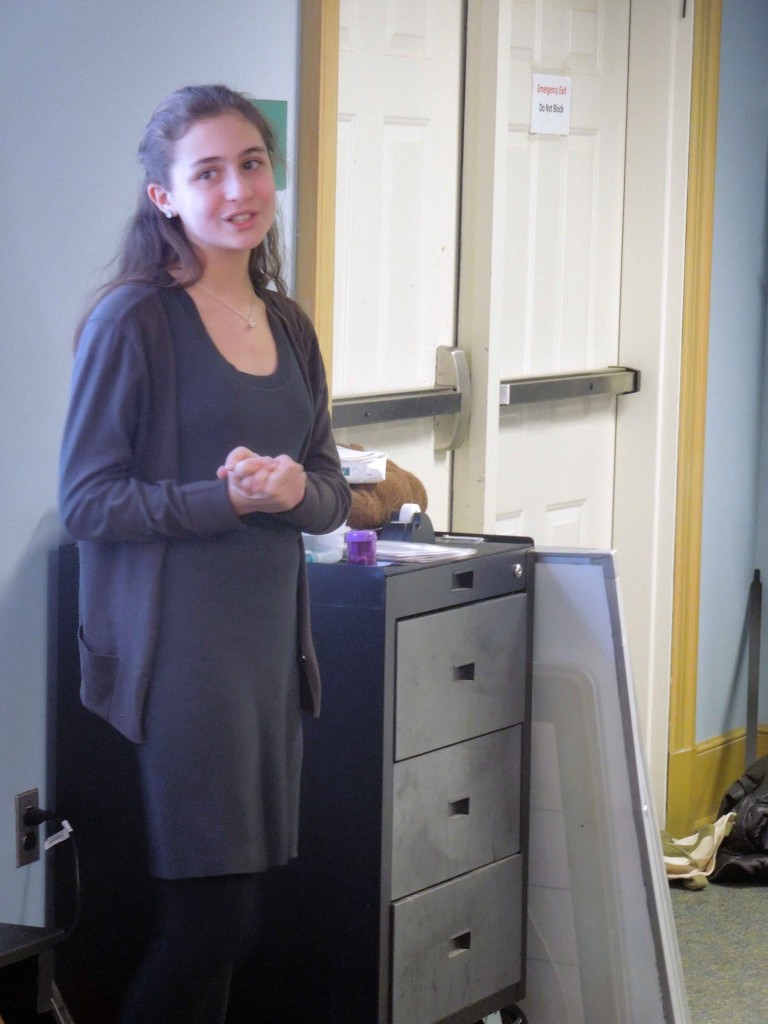by Kristen Minogue
Eleven-year-old Lucy Paskoff knows something about the hazards of filming wildlife. She and fellow home-school student McKenna Austin-Ward spent weeks documenting one of Chesapeake Bay’s most destructive pests: the mute swan.

Lucy Paskoff describes the difficulty of finding the mute swan at the student film screening at SERC. (SERC)
“The first thing that we found challenging was actually finding the mute swan,” Paksoff said. “At one point McKenna and I were not sure if we could actually get footage of a mute swan, and we had to brainstorm how we were going to make a documentary on mute swans without actual footage of a mute swan.”
When they finally tracked the swans down (with help from a neighbor), they found a series of new obstacles: the cold, the wind, and getting up close. Falling in the water turned out to be the reward for Paskoff’s determination. “I was balancing on a log,” she said at the student film screening in January. “Didn’t work out so well.”
Paskoff is one of eight home-school students who spent the fall and winter making short nature documentaries, part of a class at the Smithsonian Environmental Research Center (SERC) in Edgewater. Karen McDonald has run SERC’s home-school program for seven years. Homeschool classes are in high demand on Maryland’s western shore, and it’s not uncommon for courses to fill up hours after she posts the schedule online. But most of her classes focus on pure environmental science—such as field botany, or ornithology. Teaching film took her and her students into completely new territory.
“These students, most of them walked in here going, ‘I know what a computer is,’ and some going, ‘I think I know how to open a file,’ to, ‘Let’s make a full-blown documentary,’” McDonald said. “So these guys really started from the ground up.”
On the first day, McDonald brought in a film crew from the Smithsonian Channel to give her students technical pointers. She also gave them a springboard for choosing topics: a series of professionally made SERC documentaries called Ecosystems on the Edge. The rest of the project—screenwriting, filming, creating shot lists, storyboarding, finding and interviewing sources, music and sound recording, and editing—was in the hands of the students.
Paskoff and Austin-Ward’s 8-minute documentary, “Beauty and Beast,” uncovers the darker side of the mute swan. The swans came to America from Europe. But despite their graceful necks and immaculate white feathers, they turned out to be unwelcome guests. They feed ravenously on underwater seagrasses, which shelter imperiled sea creatures like blue crabs. A single swan can uproot up to 20 pounds of seagrass a day—even though it may eat only four or eight. Aggressive and territorial, they also drive out native swans like the tundra swan.
The other three films highlighted invasive earthworms, the plight of blue crabs, and the Bay’s chronic struggle with nutrient pollution.
Watch more student-made documentaries >>

